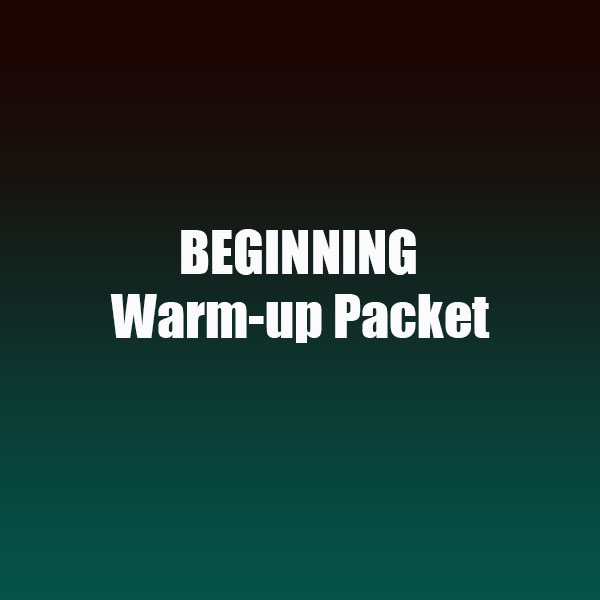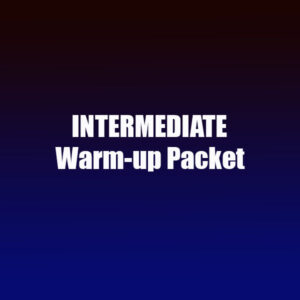Description
1. U 8 My 8s (beg)
This is a “stretch out the wrists” exercise consisting of patterns of 8 measures of 8th notes, that is usually played at the beginning of a warm up session.
Pit – This is a 2 mallet octave warm up that utilizes the diatonic major scale, changing notes on the half note, then the quarter note, then the 8th note. It should be used to stretch out the wrists and establish technique and listening at the beginning of a rehearsal. The accessory part is written on a conga drum, but can be played on a tom-tom, timbale, or even a drum pad.
Battery – This is a basic “8-on-a-hand” exercise which practices starting with both the right and left hands. The bass drum part begins with 8 notes per drum, then goes to 4 notes per drum, then 2, then finishes with a split 8th note pattern. The cymbal part is written as “hi-hats”, but could be played with a variety of different sound techniques.
2. Vanilla Shake (beg)
This is a basic “4’s, 3’s & 2’s” exercise that is commonly usde in some incarnation or another, hence the title. It switches time signatures from 4/4 to 3/4 to 2/4. This exercise should be played slow to work tempo control.
Pit – This exercise practices the chromatic scale with the vibraphone playing in octaves while the marimba part offers a 4 mallet part for more experienced players. The accessory part is written on a conga drum, but can be played on a tom-tom, timbale, or even a drum pad.
Battery – This starts as an accent/tap exercise, then changes to a “2-height” exercise, and ends as a crescendo/decrescendo exercise. The battery should put extra emphasis on controlling the low tap after each accent. The cymbal part is written as “hi-hats”, but could be played with a variety of different sound techniques.
3. In The Zone (Bonus Warm up)
This is a 16th note listening exercise to establish an ensemble sound. It is usually the first “hands together” exercise of the warm up sequence.
Pit – This is a 2-mallet exercise to practice getting an even sound and balance from all players. It goes through a series of familiar children’s songs before ending with a “5 over 4” pattern on a familiar tune.
Battery – This is a 16th note accent/tap exercise that is designed to practice controlling the taps after the accents and building a strong ensemble sound.
4. Funky Monkey
This is a 16 note warm up concentrating on 16th note patterns in the major scale and accent/taps with paradiddles.
Pit – This is a combination of octave rhythms and 16th note pattens up and down the major scale, starting with both hands. The accessory part is written on a conga drum, but can be played on a tom-tom, timbale, or even a drum pad.
Battery – This exercise alternates between simple 16th note accent/tap patterns and paradiddle patterns. The cymbal part is written as “hi-hats”, and crashes, but could be played with a variety of different sound techniques.
5. Singles Prep
This exercise is designed to build the dexterity and control needed to play “singles” (16th note triplets / single stoke rolls).
Pit – This warm up builds the chromatic scale by first playing 16 note and triplet chromatic runs with one hand first, then adding in the other hand. It includes both ascending and descending scales, starting with both the right and left hands. The accessory part is written on a 2 conga drums, but it can be played on a tom-toms, timbales, or even a drum pad.
Battery – This warm begins with 16th note and triplet single patterns with one hand omitted, then it then ads in the other hand. It is always played in two reps, one with right hand lead one with left hand lead. The cymbal part is written as “hi-hats”, but could be played with a variety of different sound techniques.
6. Wrigley’s
This is a “double beat” exercise that works the major scale and 16th note syncopations.
Pit – This is a 2-mallet exercise that goes up and down the major scale in 16th note syncopated rhythms, starting with both hands. The accessory part can be played on any non-pitched instrument.
Battery – This works the rebound stroke, one hand at a time to prepare the hands to play open rolls. The cymbal part is written as “hi-hats”, but could be played with a variety of different sound techniques.
7. Checkers
This is a major scale / roll warm up.
Pit – This is a simple diatonic major scale 16th note exercise that can be played with a “right hand lead” or a “left hand lead”. Alternating between both would be ideal. The vibraphone part offers an easier 8th note pattern for less experienced players. The accessory percussion part provides a rhythmic foundation with a conga / tambourine part that provides both time and a fun groove to play along to with .
Battery – This is an open roll exercise that utilizes “high”, “low” and crescendo rolls. The first bar should be played “up”, while the 2nd bar should be played with an “accent/tap” approach to the heights. The rolls in the 3rd and 4th bars should be crescendos, but not overplayed at the top.
8. Flam Initiation
This exercise is in 12/8 time and works 8th note and 16th note rhythms in the pit, while training the battery to play flam accents.
Pit – This exercise works 8th note and dotted 8th note rhythms in 12/8 alternates between both diatonic and chromatic scales. It has a 2-mallet part and a 4-mallet part for more experienced players. The accessory part is written on a conga drum, but can be played on a tom-tom, timbale, or even a drum pad.
Battery –This is a training exercise for playing flam accents. It starts with a right hand only flam accent pattern that then adds in the left hand. Then it works the left hand only before playing both hands together again. The cymbal part is written as “hi-hats” and “taps”, but could be played with a variety of different sound techniques.


